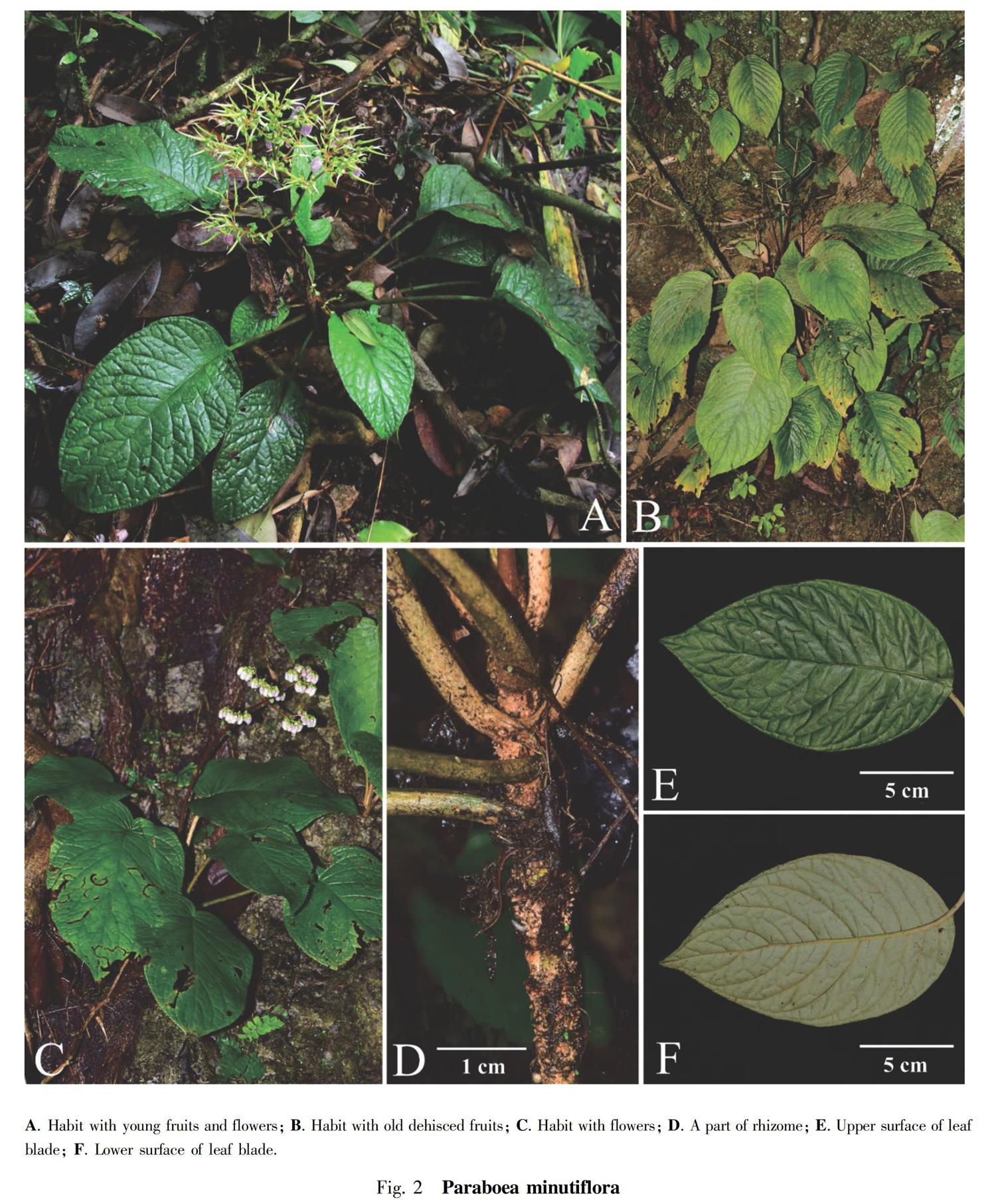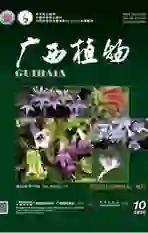微花蛛毛苣苔在中国云南的发现及其补充描述
2020-12-14陆昭岑刘恩德韩孟奇朱鑫鑫NGUYENKhangSinh许为斌
陆昭岑 刘恩德 韩孟奇 朱鑫鑫 NGUYEN Khang Sinh 许为斌



摘 要: 中越边境喀斯特地区是全球生物多样性热点地区,也是生物多样性保护的关键区域,近年来在该地区发现了多个蛛毛苣苔属植物的新种。微花蛛毛苣苔于2001年在越南北部喀斯特地区首次采集到标本,直到2018年才被发表出来,由于发表时仅基于一号花发育未成熟的標本,所以该物种的诸多形态特征仍不清楚。作者开展中越边境喀斯特地区植物多样性调查时,在我国云南东南部发现了微花蛛毛苣苔,并采集到花发育成熟的植株,对其进行了解剖观察和测量,现对该物种进行补充描述,并提供墨线图和野外生态照片以资辨认。微花蛛毛苣苔与腺花蛛毛苣苔在光滑无毛而反折的花萼以及被腺毛的花冠等形态上最相似,但不同之处在于微花蛛毛苣苔的叶上面幼时被褐色蛛丝状绵毛,后变近无毛,花序顶生,花冠长9~12 mm,蒴果直,不旋扭,长1.2~2.8 cm。微花蛛毛苣苔在滇东南的发现,说明中国南部喀斯特地区和越南北部喀斯特地区构成了一个完整的植物区系地理单元。
关键词: 生物多样性热点, 石灰岩植物区系, 中越边境喀斯特地貌
Sino-Vietnamese limestone karsts are biodiversity hotspots in the world (Myers et al., 2000; Clements et al., 2006), and many new species in the genus Paraboea (C.B. Clarke) Ridl. have been found there (Chen et al., 2008, 2012; Xu et al., 2012, 2017; Wen et al., 2013, 2016; He et al., 2018; Middleton, 2018). Paraboea minutiflora was reported from Ha Giang, northern Vietnam in 2018. But Paraboea minutiflora just only has slightly immature corollas on the specimens available for study when published (Middleton, 2018), so it is very important to give supplementary description for this insufficiently understood species. According to the original literature and specimens from southeastern Yunnan, China, the characteristics of Paraboea minutiflora are described, and line drawing and photos are also provided.
Perennial erect herb with obviously (sometimes unconspicuous) woody rootstock. Rhizomes subterete, 14-40 cm long, 5-12 mm in diameter. Leaves 6-8, congested at the apex of rhizome, long petiolate, petiole 5.5-20 cm long, 1.5-4 mm in diameter, covered with grayish to brownish matted indumentum, leaf blade 9.4-19.4 × 5.7-19.2 cm, broadly lanceolate, ovate to broadly ovate, papery, base truncate to cordate, sometimes inequilateral, apex apiculate, cuspitate to almost rounded, margin entire to minutely crenulate, upper leaf surfaces covered with brown matted indumentum when young, but glabrescent at maturity, lower leaf surfaces with brown matted indumentum, lateral veins 7-9 on each side of midrib, flat adaxially and prominent abaxially, tertiary venation conspicuously reticulate on the lower leaf surface. Inflorescences cymose, terminal (rare subterminal), with distantly spaced branches, 26.1-36 cm long, 3-4-branched, ca. 30-100 flowers; peduncle 9.5-19 cm long, 5-10 mm in diameter, with a dense matted indumentum in lower parts, glabrescent distally, and then red-purple shiny; bracts 2, opposite, green, lower pair 11-41 × 5-29 mm, upper pairs progressively smaller; pedicels
2-10 mm long, ca. 1 mm in diameter, glabrous. Calyx green, 5-parted nearly to the base, lobes oblong, reflexed, 3-3.5 × 0.8-1.2 mm, outside and inside glabrous, margins entire, apex rounded. Corolla 9-12 mm long, obliquely campanulate, white and red-pink or pale purple-blue, densely glandular-pubescent outside, glabrous or sparsely pubescent inside; tube 6-8 mm long, 4-6 mm in diameter at the mouth; the limb conspicuously 2-lipped, adaxial lip 2-lobed to near base, lobes round, 3-4 × ca. 3 mm, abaxial lip 3-lobed to over middle, lobes round, 3.5-4.5 × ca. 3.5 mm. Stamens 2, adnate to the corolla base; filaments 4-4.5 mm long, densely glandular-bearded at the middle; anthers adnate face to face, elliptic, 3.0-3.3 mm long, glabrous; staminodes 3, glandular-puberulent, lateral ones 1.0 mm long, adnate to ca. 1 mm above the corolla tube base; middle one ca. 0.2 mm long, adnate to the corolla tube base. Pistil glabrous, ovary 4-5 mm long, ca. 1.5 mm in diameter, style 4-5 mm long, stigma slightly capitate. Capsule straight, 1.2-2.8 cm long, ca. 2 mm in diameter, glabrous (old dehisced fruit).
Distribution and habitat: Paraboea minutiflora is found from Ha Giang, northern Vietnam and southeastern Yunnan, China, and only four localities have so far been identified during field investigations. Paraboea minutiflora grows under the forests of limestone karst, at an elevation between 600 m and 1 100 m.
Phenology: Flowering from February to June.
Notes: Paraboea minutiflora is similar to Paraboea thorelii (Pellegr.) B. L. Burtt and species in the Paraboea martinii (H. Lev. & Vaniot) B. L. Burtt group, but it is easily distinguished from the latters by some characters (Middleton, 2018). Paraboea minutiflora is also most similar to Paraboea glanduliflora Barnett in having glabrous, reflexed calyx and corolla with glandular hairs (Xu et al., 2008; Wang et al., 2012), but differs from the latter by the upper leaf surfaces covered with brown matted indumentum when young, but glabrescent at maturity (vs. pubescent), the inflorescences terminal (vs. subterminal), the corolla 9-12 mm long (vs. 18 mm long), the capsule straight, 1.2-2.8 cm long ( vs. spirally twisted, 3-4 cm long).
Additional specimens examined: CHINA. Yunnan : Malipo County, Tianbao Town, 22°59′24.20″ N, 104°50′12.14″ E, alt. 1 100 m, 20 June 2018, Meng-Qi Han & Wei-Bin Xu 13883 (IBK). The same locality, 10 January 2019, Xin-Xin Zhu & Wei-Bin Xu 13916 (IBK). VIETNAM. Ha Giang : Quan Ba, 104°56′01.4″ E, 23°02′55.0″ N, alt. 900-980 m, 18 October 2018, Leonid V. Averyanov et al. VR1000 (LE01049022); Phong Quang, 104°54′57.4″ E, 22°53′51.5″ N, alt. 650 m, 17 August 2019, Wei-Bin Xu et al. 13931 (IBK & HN).
The flora of Sino-Vietnamese limestone karsts belongs to the Tonkin gulf region in Paleotropic Kingdom (Wu et al., 2010), and also rich in rare and endemic plants. In recent years, many new genera or species were found firstly from northern Vietnam, and also found from southern or southwestern China at last, e.g. Caobangia A. R. Smith & X. C. Zhang (Xu et al., 2008), Xanthocyparis Farjon & Hiep (Meng et al., 2013), Zeuxinella Aver. (Huang et al., 2012), Aspidistra connata H. -J. Tillich (Xu et al., 2010), Didymoplexis vietnamica Ormd. (Huang et al., 2011), Sciaphila stellata Aver. (Jiang et al., 2011), and also including Paraboea minutiflora D. J. Middleton here.
The discovery of Paraboea minutiflora D. J. Middleton from Southeast Yunnan, China enlarge its distribution localities, and is also important to its research and conservation. Its biogeographical significance here, the flora is closely interrelated between the southern and southwestern limestone karsts of China and the northern limestone karsts of Vietnam. Sino-Vietnamese limestone karsts are naturally integrated areas, and the border just an artificial line, can not givesalient vicariances to those local wildlife. The biodiversity of Sino-Vietnamese limestone karsts is so fantastic, but the field surveys are weak, even blank in some areas, and many species face to severe threats at the same time, so more further research and conservation works are needed.
Acknowledgements The authors are grateful to Mr. LIN Wenhong (IBK) for the beautiful drawing, to Dr. WU Lei (CSFI) for his beautiful photo.
References:
CH EN WH, MOLLER M, SHUI YM, et al., 2008. A new species of Paraboea (Gesneriaceae) from a karst cave in Guangxi, China, and observations on variations in flower and inflorescence architecture [J]. Bot J Linn Soc, 158: 681-688.
CHEN WH, MOLLER M, ZHANG MD, et al., 2012. Paraboea hekouensis and P. manhaoensis, two new species of Gesne-riaceae from China [J]. Ann Bot Fenn, 49: 179-187.
CLEMENTS R, SODHI NS, SCHILTHUIZEN M, et al., 2006. Limestone karsts of Southeast Asia: Imperiled arks of biodiversity [J]. Bioscience, 56: 733-742.
HE DM, FENG YF, PAN FZ, et al., 2018. Paraboea wenshanensis, a new species of Gesneriaceae from Yunnan, China [J]. PhytoKeys, 95: 83-91.
HUANG YF, WU L, LIU Y, 2012. Zeuxinella, a new recorded genus of Orchidaceae from China [J]. J Trop Subtrop Bot, 20(2): 132-134. [黄云峰, 吴磊, 刘演, 2012. 中国兰科一新记录属—拟线柱兰属 [J]. 热带亚热带植物学报, 20(2): 132-134.]
HUANG YS, LU MX, YANG JC et al., 2011. Didymoplexis vietnamica, a newly recorded species of Didymoplexis (Orchidaceae) from China [J]. Guihaia, 31(5): 578-580. [黄俞淞, 陆茂新, 杨金财, 等, 2011. 中国双唇兰属 (兰科)一新记录种——越南双唇兰 [J]. 广西植物, 31(5): 578-580.]
JIANG RH, WU WH, NONG DX, et al., 2011. Sciaphila stellata Aver., a newly recorded species of Triuridaceae from limestone areas in China [J]. Guihaia, 31(1): 9-10. [蒋日红, 吴望辉, 农东新, 等, 2011. 中国石灰岩地区霉草科一新记录种——星状霉草 [J]. 广西植物, 31(1): 9-10.]
MENG T, PENG RC, CHUNG KF, et al., 2013. Xanthocyparis Farjon & Hiep, a newly recorded genus of Cupressaceae from China [J]. Guihaia, 33(3): 388-391. [蒙涛, 彭日成, 钟国芳, 等, 2013. 黄金柏属—中国柏科一新记录属 [J]. 广西植物, 33(3): 388-391.]
MIDDLETON DJ, 2018. Two new species of Paraboea (Gesne-riaceae) from Vietnam [J]. Edinb J Bot, 75: 421-425.
MYERS N, MITTERMEIER RA, MITTERMEIER CG, et al., 2000. Biodiversity hotspots for conservation priorities [J]. Nature, 403: 853-858.
WANG HC, SUN H, ZHOU XM, et al., 2012. Paraboea glanduliflora, a newly recorded species of Paraboea (Gesneriaceae) from China [J]. Guihaia, 32(6): 756-758. [王煥冲, 孙航, 周新茂, 等, 2012. 腺花蛛毛苣苔——中国苦苣苔科蛛毛苣苔属一新记录种 [J]. 广西植物, 32(6): 756-758.]
WEN F, HONG X, CHEN LY, et al., 2013. A new species of Paraboea (Gesneriaceae) from a karst limestone hill in southwestern Guangdong, China [J]. Phytotaxa, 131: 1-8.
WEN F, WEI YG, 2016. Paraboea yunfuensis: A new calcicolous species of Gesneriaceae from Yunfu, Guangdong Province, China [J]. Telopea, 19: 125-129.
XU WB, GUO J, PAN B, et al., 2017. Three new species of Paraboea (Gesneriaceae) from limestone karsts of China based on morphological and molecular evidence [J]. Bot Stud, 58: 56.
XU WB, HUANG YS, WEI GF, et al., 2012. Paraboea angustifolia (Gesneriaceae): A new species from limestone areas in northern Guangxi, China [J]. Phytotaxa, 62: 39-43.
XU WB, HUANG YS, YE XX, et al., 2010. Aspidistra connata H.-J. Tillich, a newly recorded species of Aspidistra (Ruscaceae) from China [J]. Guihaia, 30(5): 613-615. [许为斌, 黄俞淞, 叶晓霞, 等, 2010. 中国蜘蛛抱蛋属一新记录种—合瓣蜘蛛抱蛋 [J]. 廣西植物, 30(5): 613-615.]
XU WB, LIANG YY, ZHANG XC, et al., 2008. Caobangia A. R. Smith & X. C. Zhang (Polypodiaceae): A newly recorded fern genus from China [J]. Acta Phytotax Sin, 46(6): 916-918. [许为斌, 梁永延, 张宪春, 等, 2008. 中国水龙骨科一新记录属——高平蕨属 [J]. 植物分类学报, 46(6): 916-918.]
XU ZR, BURTT BL, SKOG LE, et al., 2008. A revision of Paraboea (Gesneriaceae) [J]. Edinb J Bot, 65: 161-347.
WU ZY, SUN H, ZHOU ZK, et al., 2010. Floristics of seed plants from China [M]. Beijing: Science Press: 100-102. [吴征镒, 孙航, 周浙昆, 等, 2010. 中国种子植物区系地理 [M]. 北京: 科学出版社: 100-102.]
( 责任编辑 李 莉 )
